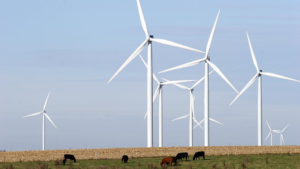Skip to content
Experts say wind-plus-storage could become viable with longer-duration batteries.

Figure 1. Eolic Energy, Wind Turbines.
Energy storage is storming the U.S. power industry, driving changes from the bulk system level to the customer level.
At the system level, February’s Federal Energy Regulatory Commission (FERC) Order 845 required bulk system operators to design new rules to integrate storage. April’s Order 841 rewrote the rules on interconnection, opening new opportunities for storage.
At the customer level, state lawmakers and regulators in 32 states considered 57 policy actions on deployment, targets, studies and rebates for energy storage in Q1 of this year.
Until about 2015, utility executives and renewable energy skeptics regarded cost-competitive battery energy storage as unachievable. Today, it is a central focus of the power sector.

Figure 2. Eolic Energy, Wind Turbines.
“We always called it the ‘holy grail’ because we knew too much wind and solar would break the grid without energy storage, but we thought it would always be too expensive,” former Southern California Edison VP Jim Kelly told in a 2015 conference.
As the stack of services storage can offer, including capacity and resilience, became understood, it went from a holy grail to the hottest topic in energy. Lithium-ion batteries have captured the most attention, but there are several other fast-advancing battery chemistries and storage technologies, according to the November 2017 Levelized Cost of Storage Analysis from Lazard.
Battery storage’s cost is highly variable because of the range of technologies and applications, but the much-discussed cost plummet is real. The overall estimated cost fell 32% in 2015 and 2016, according to the 2017 GTM Reseach utility-scale storage report. That will slow over the next five years, GTM reported. But battery storage is — in certain places and applications — on its way to cost-competitiveness.
Industry insiders expect a cumulative drop in the levelized cost, depending on location and application, as much as 36% between 2018 and 2022, according to Lazard.

Figure 3. Eolic Energy, Wind Turbines.
Those prices are leading many renewable energy developers to pair their solar projects with energy storage. In California, the nation’s dominant solar energy state, the Solar Energy Industries Association chapter formally revised its name to the California Solar and Storage Association this February.
The early success of solar-plus-storage is leading some developers to consider combining batteries with large wind projects, but researchers and industry officials say storage technologies will need to develop further before the paired resource is competitive.
The current capital cost for storage, which was $1,000/kWh in 2012, is estimated as low as $200/kWh, according to a study from the National Renewable Energy Laboratory (NREL) previewed May 10 at the American Wind Energy Association’s (AWEA) annual national wind energy conference. The study foresees the capital cost for battery storage falling to $100/kWh — but does not conclude it will be cost competitive for wind.


